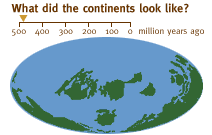Explore an Era:
Ordovician
500 - 438 million years ago
Warm climate, followed by global cooling and glaciation |
High sea levels at first; North America under shallow seas |
Primitive plants appear on land |
Primitive fishes, bivalves and gastropods |
None |
|||||
The Ordovician is best known for the presence of its diverse marine invertebrates, including graptolites, trilobites, brachiopods, and some early vertebrates. A typical marine community consisted of these animals, plus red and green algae, primitive fish, cephalopods, corals, crinoids, and gastropods. Evidence also suggests that plants invaded the land at this time.
In the early Ordovician, the climate was mild, with a lot of moisture. As the land masses moved towards the south Pole, however, massive glaciers formed, causing the sea levels to drop. This may be the cause for the large extinctions at the end of the period, which affected almost 60% of the marine invertebrates and 25% of all families.
